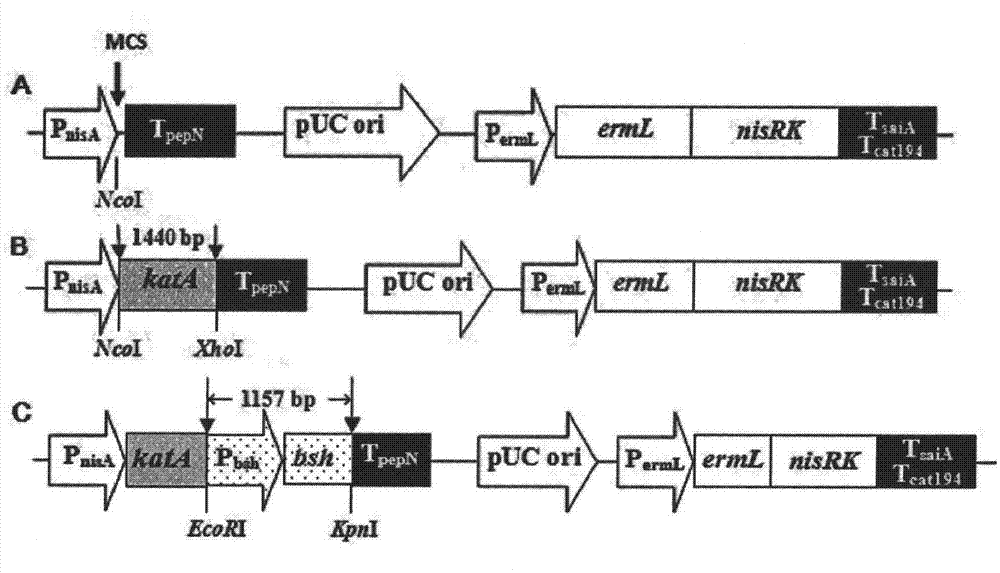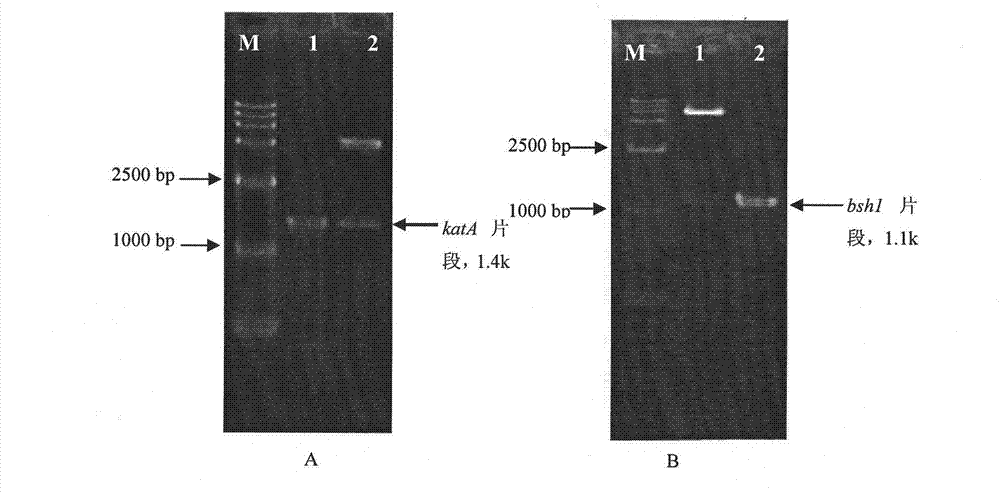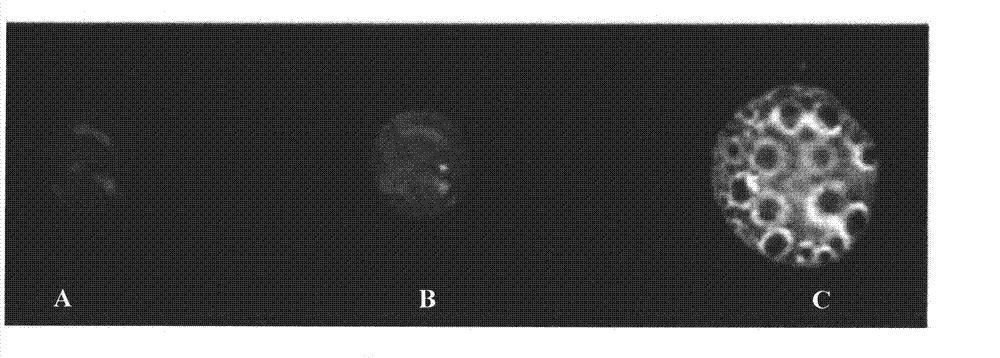Recombinant lactobacillus casei engineering strain and preparation method thereof
A technology of Lactobacillus casei and engineering strains, which is applied in the field of recombinant Lactobacillus casei engineering strains and its preparation, can solve the problems of cell death product quality, strain survival rate decline, decline, etc., to improve antioxidant and bile salt resistance Ability, the effect of improving the ability to withstand GDCA
- Summary
- Abstract
- Description
- Claims
- Application Information
AI Technical Summary
Problems solved by technology
Method used
Image
Examples
Embodiment 1
[0027] Embodiment 1 carries the construction of the plasmid vector of purpose gene katA
[0028] 1.1 Genomic DNA extraction of Lactobacillus sake
[0029] The genome was extracted using a bacterial genome DNA extraction kit (Tiangen Biochemical Technology (Beijing) Co., Ltd.), the method is as follows:
[0030] (1) Take 5ml of Lactobacillus sake cultured to the logarithmic phase, centrifuge at 12000rpm for 1 minute, discard the supernatant, add 200μl TES to resuspend once, centrifuge at 12000rpm for 1 minute, and suck off the supernatant as much as possible;
[0031] (2) Add 180 μl lysozyme (20mg / ml), and treat in a water bath at 37°C for 1 hour;
[0032] (3) Add 20 μl RNase (10mg / ml), shake slightly for 15 seconds, and place at room temperature for 5 minutes;
[0033] (4) Add 20 μl proteinase K solution and mix gently;
[0034] (5) Add 220 μl buffer GB, shake for 15 seconds, treat in a 70°C water bath for 10 minutes, and briefly centrifuge to remove water droplets on the t...
Embodiment 2
[0075] Example 2 Construction of a double-gene plasmid vector carrying the target gene bsh1 and katA
[0076] 2.1 Genomic DNA extraction of Lactobacillus plantarum
[0077] The genomic DNA of plantarum lactobacillus was extracted, and the method was the same as in Example 1.
[0078] 2.2PCR amplification of bile salt hydrolase gene
[0079] Design specific primers to amplify bile salt hydrolase gene bsh1 and its upstream promoter sequence from the genome of Lactobacillus plantarum. The primer sequences are as follows:
[0080] Upstream primer: 5'-CG GAATTC TATATCGGTTATAAGGG-3'
[0081] Downstream primer: 5'GG GGTACC TTAGTTAACTGCATAGT-3'
[0082] EcoR I and Kpn I restriction sites are introduced into the primer sequence, that is, the underlined part in the sequence.
[0083] The PCR reaction procedure is the same as in Example 1, wherein the template is the genomic DNA of Lactobacillus plantarum.
[0084] The PCR program is as follows:
[0085] Pre-denaturation at 95°...
Embodiment 3
[0087] Embodiment 3 prepares recombinant Lactobacillus casei engineering strain
[0088] 3.1 Preparation of competent cells of Lactobacillus casei
[0089] Cultivate Lactobacillus casei with MRSS (MRS, 0.3M sucrose, 1% glycine) medium, grow to OD 600 =0.4~0.6, take 10ml of bacterial liquid, centrifuge at 6000rpm, 4°C for 8min, collect bacterial cells; add 2ml of rinse solution (0.3M sucrose, 1mM MgCl 2 ) resuspended twice, centrifuged at 6000rpm, 4°C for 8min, discarded the supernatant; added 2ml 30% PEG-1500 resuspended cells, centrifuged at 6000rpm, 4°C for 10min, discarded the supernatant, and re-suspended with 200μl 30%PEG-1500 Suspended, 40μl aliquots for use.
[0090] 3.2 Electrotransformation of Lactobacillus casei with recombinant plasmid
[0091] Take 40 μl of competent cells of Lactobacillus casei, mix with 2 μl of recombinant plasmid pSIPCB, transfer to a 2mm electroporation cup, use Bio-Rad Gene Pulser Xcell TM Type electric conversion instrument, the electric ...
PUM
 Login to View More
Login to View More Abstract
Description
Claims
Application Information
 Login to View More
Login to View More - R&D
- Intellectual Property
- Life Sciences
- Materials
- Tech Scout
- Unparalleled Data Quality
- Higher Quality Content
- 60% Fewer Hallucinations
Browse by: Latest US Patents, China's latest patents, Technical Efficacy Thesaurus, Application Domain, Technology Topic, Popular Technical Reports.
© 2025 PatSnap. All rights reserved.Legal|Privacy policy|Modern Slavery Act Transparency Statement|Sitemap|About US| Contact US: help@patsnap.com



